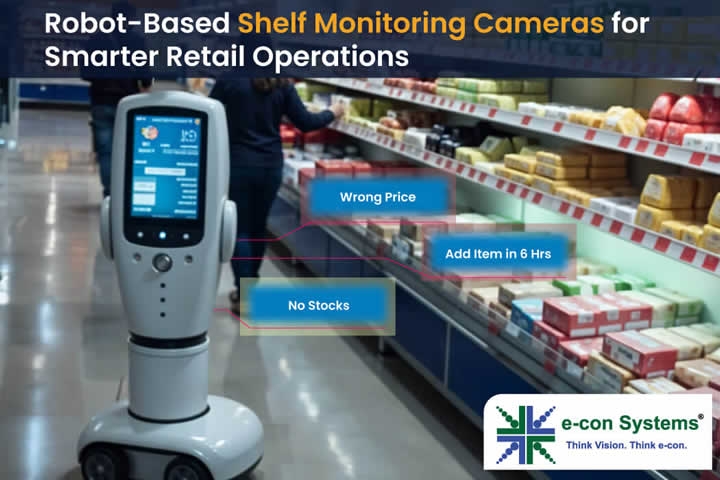Robot-based shelf monitoring systems integrate camera systems with autonomous robotics. It helps ensure seamless inventory tracking, planogram compliance, and shelf organization. Discover how these camera-based systems work and their must-have imaging features.
Ranjith Kumar | e-con Systems
Retail management has undergone a significant transformation in recent years, driven by the need for operational efficiency and enhanced customer experience. One such innovation is the deployment of moving robot-based shelf monitoring cameras, a solution tailored to modern retail’s dynamic demands. This technology integrates advanced camera systems with autonomous robotics, ensuring seamless inventory tracking, planogram compliance, and shelf organization. Let’s delve into how these solutions work and their standout features.
Traditional shelf monitoring methods often rely on manual audits, which are time-consuming, error-prone, and labor-intensive. With increasing SKU (Stock Keeping Unit) diversity and rapid inventory turnover in retail, these methods fall short of ensuring optimal shelf management.
Robot-based shelf monitoring cameras offer an automated solution to these challenges. By patrolling aisles and capturing real-time shelf data, these robots empower retailers to:
- Identify and address stockouts swiftly.
- Ensure planogram compliance.
- Optimize inventory replenishment cycles.
- Improve overall customer satisfaction by maintaining well-stocked and organized shelves.
Key Features of Moving Robot-Based Shelf Monitoring Cameras
The effectiveness of this solution lies in the advanced features of the cameras used.
Below are the core functionalities and technologies that make these cameras indispensable for retail:
1) High-resolution imaging
High-resolution sensors enable accurate capture of product packaging, barcodes, and electronic shelf labels (ESL). The clarity ensures that even small print and compact labels are captured without visual noise. In turn, this supports reliable stock detection, price verification, and product recognition during robotic aisle scans.
2) Optics and DoF (Depth of Field)
Retail aisles vary in width, and shelf heights differ across product categories. So, cameras must account for these variations using optics with the correct depth of field. Fixed focus lenses maintain consistency when the robot path is uniform. On the other hand, auto-focus models adjust dynamically based on changes in shelf distance for uninterrupted capture of relevant data.
3) Varied lighting performance
As you can imagine, lighting conditions in retail settings tend to be far from uniform. Cameras may encounter overexposed packaging, shadow-heavy corners, or mixed light sources. That’s why camera modules equipped with dynamic light handling, including HDR and on-the-fly exposure adjustments, are important. They deliver stable image output across these shifts, providing usable frames without requiring repeated passes.
4) Multi-camera synchronization
Monitoring entire shelf segments requires multiple viewing angles. With multi-camera setups, robots can capture side-by-side shelves or different shelf tiers in a single route. These arrays work in tandem, which reduces blind spots and improves coverage. The result? It leads to better shelf visibility and fewer inspection gaps.
5) Seamless platform compatibility
Advanced retail robotics platforms depend on scalable integration. For instance, camera modules compatible with NVIDIA Jetson AGX Orin can support input from up to 16 channels, enabling high-speed, multi-camera capture. Such setups deliver parallel video streams for real-time processing, visual stitching, and inference without overload.
6) Depth perception for navigation
Navigation through crowded or narrow aisles requires spatial awareness. Therefore, depth cameras based on Time-of-Flight (ToF) or stereo vision can be tremendously useful. They empower robots to detect shelf edges, floor obstacles, and customer movement. It helps enhance localization and prevent collisions so that retailers can ensure safe and accurate path planning during monitoring routines.
How Moving Robot-Based Cameras Transform Retail Operations
Enhanced Inventory Accuracy: Real-time data from these cameras minimizes the risk of human errors, ensuring more accurate inventory records. Retailers can make informed decisions about restocking and inventory management.
Improved Planogram Compliance: By comparing captured images with planogram layouts, retailers can ensure that products are displayed correctly, maintaining brand guidelines and maximizing visual appeal.
Cost Efficiency: Automating shelf monitoring reduces the need for manual audits, saving labor costs and reallocating workforce to customer-centric roles.
Data-Driven Insights: Historical data collected by the cameras enables trend analysis, helping retailers predict demand, optimize shelf space, and plan promotions effectively.
Scalability: Moving robot-based solutions can easily scale with store expansion. Robots can be programmed to navigate new layouts and integrate seamlessly with additional cameras.
Applications Across Retail Sectors
The versatility of moving robot-based shelf monitoring cameras makes them suitable for:
- Grocery Stores: Monitoring perishable and non-perishable goods for stock levels and freshness.
- Department Stores: Ensuring proper placement of diverse product categories.
- Specialty Retail: Maintaining compliance for high-value or regulated items.
- Warehouse Clubs: Managing bulk items and ensuring accessibility.
While moving robot-based shelf monitoring cameras offer immense benefits, their adoption comes with challenges such as initial investment costs, integration with existing systems, and staff training. However, with advancements in robotics and AI, these barriers are gradually diminishing.
Looking ahead, we can expect these systems to become even more intelligent, with features like predictive analytics, voice-guided issue resolution, and augmented reality interfaces for enhanced user interaction.
Why Choose e-con Systems Cameras for Your Retail Store Shelf Monitoring Needs?
e-con Systems has 20+ years of experience in designing, developing, and manufacturing OEM cameras. We have now ventured into providing camera solutions for shelf-monitoring – for retail displays in environments such as retail stores, warehouses, and distribution centers.
We offer a range of cameras optimized for retail environments, including:
For more information, visit our Retail Page.
A new addition to our retail portfolio is the AI-powered SHELFVista camera, featuring a high-resolution sensor with up to 20MP. This compact camera is purpose-built to monitor shelf stock levels and product arrangement. It delivers critical insights to support timely restocking and efficient inventory management.
SHELFVista cameras can be connected to external backend systems via Wi-Fi (2.5 GHz to 5 GHz), allowing businesses to manage storage and analysis independently. This GPDR- compliant camera comes with a rechargeable battery, custom enclosures, and mounting options and can be configured for both Android and iOS.
 Ranjith Kumar is a camera solution architect with over 16 years of experience in embedded product development, electronics design, and product solutioning. In e-con Systems, he has been responsible for building 100+ vision solutions for customers spanning multiple areas within retail including self service kiosks, access control systems, smart checkouts and carts, retail monitoring systems, and much more.
Ranjith Kumar is a camera solution architect with over 16 years of experience in embedded product development, electronics design, and product solutioning. In e-con Systems, he has been responsible for building 100+ vision solutions for customers spanning multiple areas within retail including self service kiosks, access control systems, smart checkouts and carts, retail monitoring systems, and much more.
The content & opinions in this article are the author’s and do not necessarily represent the views of RoboticsTomorrow

e-con Systems
Since 2003, e-con Systems® has been designing, developing & manufacturing custom and off-the-shelf OEM camera solutions. Backed by a large in-house team of experts, our cameras are currently embedded in 350+ customer products. So far, we have shipped over 2 million cameras to the USA, Europe, Japan, South Korea, & more. Our portfolio includes MIPI, GMSL, GigE, USB cameras, ToF & Stereo cameras & smart AI cameras. They come with industry-leading features, including low-light performance, HDR, global shutter, LED flicker mitigation, multi-camera synchronization, & IP69K-rated enclosure. e-con Systems® also offers TintE™ - an FPGA-based ISP with all necessary imaging pipeline components. It provides a full ISP pipeline as a turnkey solution, featuring optimized, customizable blocks like debayering, AWB, AE, gamma correction and more. Our powerful partner ecosystem, comprising sensor partners, ISP partners, carrier board partners, & more, enables us to offer end-to-end vision solutions.
Other Articles
Deep Dive into integration challenges of ONVIF-compliant GigE cameras and how ONVIF enhances interoperability
Importance of Global Shutter Cameras for Industrial Automation Systems
What Is The Role of Embedded Cameras in Smart Warehouse Automation?
More about e-con Systems
Featured Product


